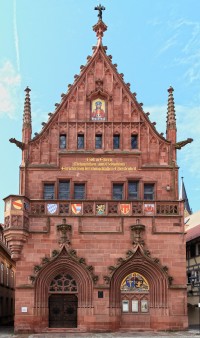Vorderseite: Luther (rechts) und Melanchthon (links) stehend von vorne, die Confessio Augustana mit der Inschrift A - C haltend, zu Luthers Füßen ein Schwan nach rechts. Umschrift: * IVBILANT IVBILANT CORAM DEO VT VIVENTES; darunter: RPW. / VTRUMQVE
Rückseite: Im Feld in neun Zeilen Schrift: + D.XXV.IVNII / MDCXXX / IVBILAT / ECCL: AVG: CONFESS: / SECVNDO IVBILAEO / ET QVIDEM / NON SINE OMINE / SEDE VACANTE / PAPAEA.; im Abschnitt: S. D.
Martin Luther (1483 – 1546) und Philipp Melanchthon (1497 – 1560)
en

